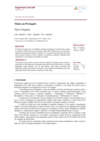Comparação económica e ambiental entre a reabilitação do Palácio Condes de Murça e uma construção nova equivalente
DOI:
https://doi.org/10.21814/ecum.4184Resumo
Na maioria dos países desenvolvidos, dos quais fazem parte os países da União Europeia, verifica-se a existência de um excedente de edifícios, cuja maioria necessita de obras urgentes de reabilitação e reforço. No que diz respeito ao reforço sísmico, tais exigências são ainda mais prioritárias em países que se localizem em zonas de sismicidade elevada, como é o caso de Portugal. No entanto, a solução para este problema pode não passar obrigatoriamente por uma reabilitação. Uma demolição seguida de uma reconstrução também respeita tais exigências e também contribui para uma renovação do parque construído. Assim, através da teoria do ciclo de vida, este trabalho procura perceber se a reabilitação é mais sustentável ambiental e economicamente do que uma construção nova equivalente, edificada sob as mesmas condicionantes. Numa primeira abordagem, recorre-se a uma
comparação teórica de vários estudos de avaliação do ciclo de vida realizados internacionalmente para edifícios reabilitados e para edifícios novos. Posteriormente, procede-se a uma avaliação do ciclo de vida de uma reabilitação real de um antigo palácio de Lisboa, que é comparada com uma demolição hipotética seguida de uma reconstrução integral em betão armado, obra que se
realizaria no mesmo local sob as mesmas condicionantes. Como conclusões, verifica-se que ambientalmente a reabilitação aparenta ser mais benéfica do que a construção nova equivalente, embora no caso avaliado os ganhos não sejam tão positivos quanto seria expectável, devido à utilização massiva da estrutura metálica e do betão projectado na obra de reabilitação. Por fim, a avaliação
económica permitiu concluir que a reabilitação é mais cara do que a construção nova equivalente, o que reforça a necessidade de desenvolvimento de soluções mais viáveis economicamente, mecanismos financeiros e de um estudo económico e ambiental integrado, durante uma acção de tomada de decisão.
Referências
Abeysundra, U., Babel, S., Gheewala, S. (2007). A decision making matrix with life cycle perspective of materials for roofs in Sri Lanka, Materials & Design, 28(9), pp. 2478-2487. DOI: https://doi.org/10.1016/j.matdes.2006.09.011
Afonso, A.S., Rodrigues, C.P. (2010). Avaliação do impacte global em Portugal da adoção de medidas de eficiência hídrica ao nível dos produtos, Actas do Congresso de Inovação na Construção Sustentável 2010, Curia, Portugal, pp. 47-57.
Ardente, F., Beccali, M., Cellura, M., Mistreta, M. (2011). Energy and environmental benefits in public buildings as a result of retrofit actions, Renewable and Sustainable Energy Reviews, 15(1), pp. 460-470. DOI: https://doi.org/10.1016/j.rser.2010.09.022
Ardente, F., Beccali, M., Cellura, M., Mistretta, M. (2008). Building energy performance: A LCA case study of kenaf-fibres insulation board, Energy and Buildings, 40(1), pp. 1-10. DOI: https://doi.org/10.1016/j.enbuild.2006.12.009
Battisti, R., Corrado, A. (2005). Environmental assessment of solar thermal collectors with integrated water storage, Journal of Cleaner Production, 13(13-14), pp. 1295-1300. DOI: https://doi.org/10.1016/j.jclepro.2005.05.007
Bin, G., Parker, P. (2012). Measuring buildings for sustainability: Comparing the initial and retrofit ecological footprint of a century home - The REEP House, Applied Energy, 93, pp.24-32. DOI: https://doi.org/10.1016/j.apenergy.2011.05.055
Dylewski, R., Adamczyk, J. (2011). Economic and environmental benefits of thermal insulation of building external walls, Building and Environment, 46(12), pp. 2615-2623. DOI: https://doi.org/10.1016/j.buildenv.2011.06.023
Eaton, K., Amato, A. (1998). A Comparative Life Cycle Assessment of Steel and Concrete Framed Office Buildings, Journal of Constructional Steel Research, 46(1-3), pp. 286-287. DOI: https://doi.org/10.1016/S0143-974X(98)00074-1
Eurostat (2012a). Final energy consumption, by sector, disponível na Internet em http://epp.eurostat.ec.europa.eu/tgm/refreshTableAction.do?tab=table&plugin=1&pcode=tsdpc320&language=en
Eurostat (2012b). Generation of waste by economic activity, disponível na Internet em: http://epp.eurostat.ec.europa.eu/tgm/table.do?tab=table&init=1&language=en&pcode=ten00106&plugin=1
Ewing, B., Moore, D., Goldfinger, S., Oursler, A., Reed, A., Wackernagel, W. (2010). The ecological Footprint Atlas 2010, Global Footprint Network, EUA.
Faucheux, S., O’Connor, M., Der Straaten, J.V. (1998). Economy and Environment: Sustainable development: concepts, rationalities, and strategies, Volume 13, Springer, Holland. DOI: https://doi.org/10.1007/978-94-017-3188-1
Ferreira, T., Correia, A. (2007). Palácio Murça - Relatório Histórico, Portugal.
Finnveden, G., Hauschild, M.Z., Ekvall, T., Guinée, J., Heijungs, R., Hellweg, S., Koehler, A., Pennington, D., Suh, S. (2009). Recent developments in Life Cycle Assessment, Journal of Environmental Management, 91(1), pp. 1-21. DOI: https://doi.org/10.1016/j.jenvman.2009.06.018
Frey, P., Dunn, L., Cochran, R., Spataro, K., McLennan, J.F., DiNola, R., Tallering, N., McDaniel, E., Haas, D., Heider, B., Clem, S., Pike, A., Dettling, J., Humbert, S. (2011). The Greenest Building: Quantifying the Environmental Value of Building Reuse, National Trust for Historic Preservation, EUA.
Goedkoop, M., Schryver, A.D., Oele, M., Durksz, S., de Roeste, D. (2010). Introduction to LCA with Simapro 7, PRé Consultants, Países Baixos.
Goodking, D. (2011). The World Population at 7 Billion, Population Division, US Census Bureau, disponível na Internet em: http://blogs.census.gov/2011/10/31/the-world-population-at-7 billion/http://ec.europa.eu/enterprise/sectors/construction/competitiveness/life-cycle-costing.
Huntzinger, D., Eatmon, T. (2009). A life-cycle assessment of Portland cement manufacturing: comparing the traditional process with alternative technologies, Journal of Cleaner Production, 17(7), pp. 668-675. DOI: https://doi.org/10.1016/j.jclepro.2008.04.007
Instituto Nacional de Estatística (2012a). Estatísticas da Construção e Habitação 2011, Instituto Nacional de Estatística, Portugal.
Instituto Nacional de Estatística (2012b). Resultados preliminares dos Censos 2011, disponível na Internet em: http://www.ine.pt
Ireland, D. (2008). New tricks with old bricks. How reusing old buildings can cut carbon emissions, The Empty Houses Agency, UK.
ISO - International Organization for Standardization, Environmental management (1997). Life cycle assessment - Principles and framework, International Standard ISO 14040, First edition, International Organization for Standardization.
ISO - International Organization for Standardization, Environmental management (2006) - Life Cycle Assessment - Requirements and guidelines, International Standard ISO 14044, First Edition, International Organization for Standardization.
Kellenberger, D., Althaus, H.-J. (2009). Relevance of simplifications in LCA of building components, Building and Environment, 44(4), pp. 818-825. DOI: https://doi.org/10.1016/j.buildenv.2008.06.002
Kosareo, L., Ries, R. (2007). Comparative environmental life cycle assessment of green roofs, Building and Environment, 42(7), pp. 2606-2613. DOI: https://doi.org/10.1016/j.buildenv.2006.06.019
Langdon, D. (2007). Life Cycle Costing (LCC) as a contribution to sustainable construction: a common methodology, disponível na Internet em:
Moraes, C., Kieling, A., Caetano, M.; Gomes, L. (2010). Life cycle analysis (LCA) for the incorporation of rice husk ash in mortar coating, Resources, Conservation and Recycling, 54(12), pp. 1170-1176. DOI: https://doi.org/10.1016/j.resconrec.2010.03.012
Nicoletti, G., Notarnicola, B., Tassielli, G. (2002). Comparative Life Cycle Assessment of flooring materials: ceramic versus marble tiles, Journal of Cleaner Production, 10(3), pp. 283-296. DOI: https://doi.org/10.1016/S0959-6526(01)00028-2
Ortiz, O., Castells, F., Sonnemann, G. (2009). Sustainability in the construction industry: A review of recent developments based on LCA, Construction and Building Materials, 23(1), pp. 28-39. DOI: https://doi.org/10.1016/j.conbuildmat.2007.11.012
Ortiz, O., Pasqualino, J., Díez, G., Castells, F. (2010). The environmental impact of the construction phase: An application to composite walls from a life cycle perspective, Resources, Conservation and Recycling, 54(11), pp. 832-840. DOI: https://doi.org/10.1016/j.resconrec.2010.01.002
Ottelé, M., Perini, K., Fraaij, A., Haas, E., Raiteri, R. (2011). Comparative life cycle analysis for green façades and living wall systems, Energy and Buildings, 43(12), pp. 3419-3429. DOI: https://doi.org/10.1016/j.enbuild.2011.09.010
Papadoulos, A., Giama, E. (2007). Environmental performance evaluation of thermal insulation materials and its impact on the building, Building and Environment, 42(5), pp. 2178-2187. DOI: https://doi.org/10.1016/j.buildenv.2006.04.012
Pehnt, M. (2006). Dynamic life cycle assessment (LCA) of renewable energy technologies, Renewable Energy, 31(1), pp. 55-71. DOI: https://doi.org/10.1016/j.renene.2005.03.002
Petersen, A., Solberg, B. (2005). Environmental and economic impacts of substitution between wood products and alternative materials: a review of micro-level analyses from Norway and Sweden, Forest Policy and Economics, 7(3), pp. 249-259. DOI: https://doi.org/10.1016/S1389-9341(03)00063-7
Ramesh, T., Prakash, R., Shukla, K., (2010). Life cycle energy analysis of buildings: An overview, Energy and Buildings, 42(10), pp. 1592-1600. DOI: https://doi.org/10.1016/j.enbuild.2010.05.007
Reza, B., Sadiq, R., Hewage, K. (2011). Sustainability assessment of flooring systems in the city of Tehran: An AHP-based life cycle analysis, Construction and Building Materials, 25(4), pp. 2053-2066. DOI: https://doi.org/10.1016/j.conbuildmat.2010.11.041
Rivela, B., Moreira, M., Muñoz, I., Rieradevall, J., Feijoo, G. (2006). Life cycle assessment of wood wastes: A case study of ephemeral architecture, The Science of the total environment, 357(1-3), pp. 1-11. DOI: https://doi.org/10.1016/j.scitotenv.2005.04.017
Sartori, I., Hestnes, A. (2007). Energy use in the life cycle of conventional and low-energy buildings: A review article, Energy and Buildings, 39(3), pp. 249-257. DOI: https://doi.org/10.1016/j.enbuild.2006.07.001
Sharma, A., Saxena, A., Sethi, M., Shree, V., Varun. (2011). Life cycle assessment of buildings: A review, Renewable and Sustainable Energy Reviews, 15(1), pp. 871-875. DOI: https://doi.org/10.1016/j.rser.2010.09.008
Software Gabi, disponível na Internet em: http://www.gabi-software.com/international/index/
Su, X., Zhang, X. (2010). Environmental performance optimization of window–wall ratio for different window type in hot summer and cold winter zone in China based on life cycle assessment, Energy and Buildings, 42(2), pp. 198-202. DOI: https://doi.org/10.1016/j.enbuild.2009.08.015
Syrrakou, E., Papaefthimiou, S., Yianoulis, P. (2006). Eco-efficiency evaluation of a smart window prototype, The Science of the total environment, 359(1-3), pp. 267-282. DOI: https://doi.org/10.1016/j.scitotenv.2005.10.023
Tarantini, M., Loprieno, A., Porta, P. (2009). A life cycle approach to Green Public Procurement of building materials and elements: A case study on windows, Energy, 36(5), pp. 2473-2482. DOI: https://doi.org/10.1016/j.energy.2011.01.039
Techato, K.-A., Watts, D., Chaiprapat, S. (2009). Life cycle analysis of retrofitting with high energy efficiency air-conditioner and fluorescent lamp in existing buildings, Energy Policy, 37(1), pp. 318-325. DOI: https://doi.org/10.1016/j.enpol.2008.08.021
US Census Bureau (2004). Global Population Profile 2002 - International Population Reports, US Census Bureau/US Government Printing Office, EUA.
Website comercial do empreendimento do Palácio condes de Murça, disponível na Internet em: http://palaciocondesdemurca.com
Zhong, Z., Song, B., Loh, P. (2011). LCAs of a polycrystalline photovoltaic module and a wind turbine, Renewable Energy, 36(8), pp. 2227-2237. DOI: https://doi.org/10.1016/j.renene.2011.01.021
Downloads
Publicado
Como Citar
Edição
Secção
Licença
Direitos de Autor (c) 2022 J. Ferreira, M.D. Pinheiro, J. Brito

Este trabalho encontra-se publicado com a Licença Internacional Creative Commons Atribuição 4.0.








